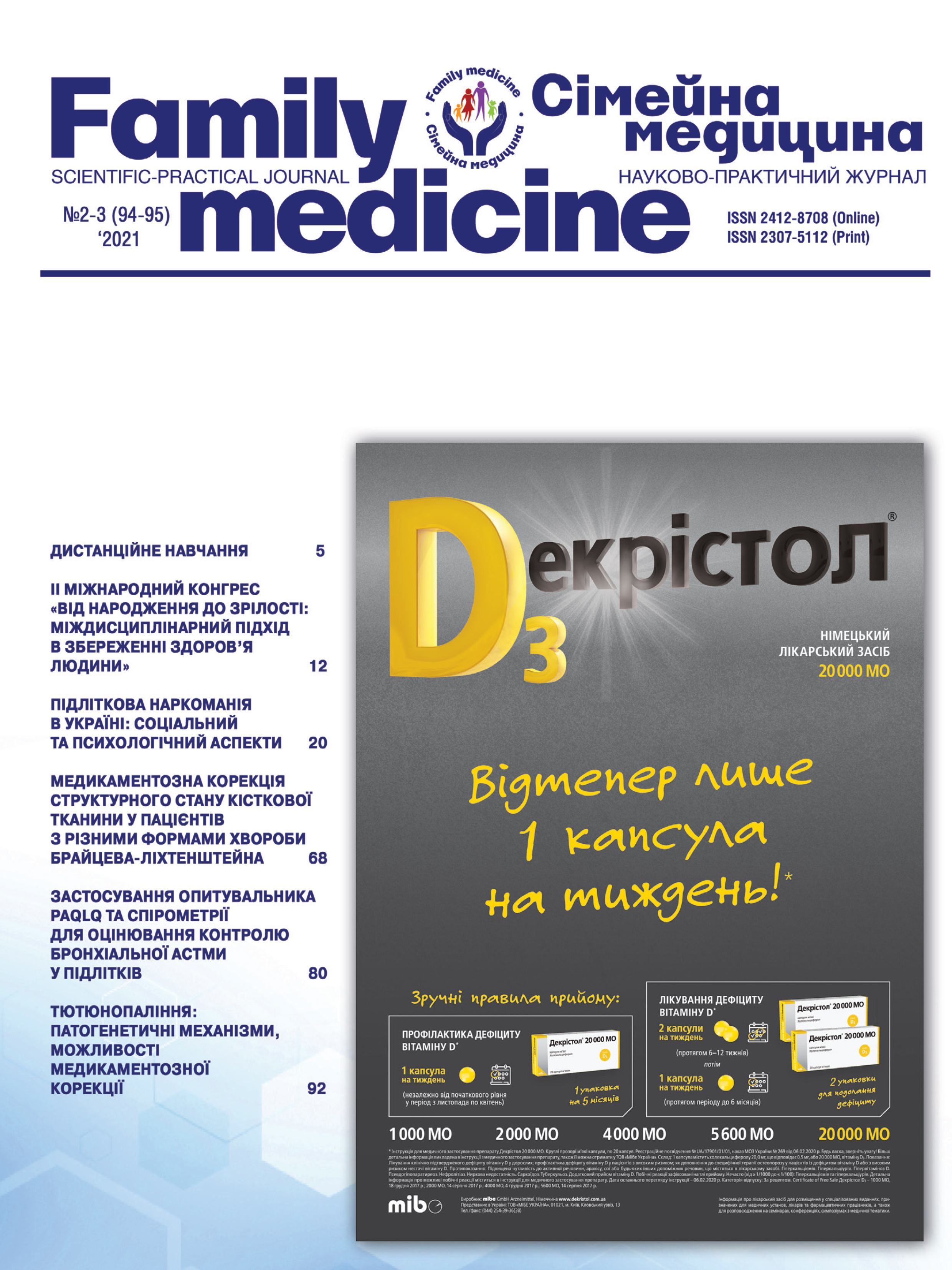Assessment of the Relationship Between Bone Mineral Density and Fracture Risk Factors in the Family Doctor Practice
##plugins.themes.bootstrap3.article.main##
Abstract
Osteoporosis is the fourth most common after cardiovascular, cancer and endocrine diseases. According to WHO experts, due to the aging population and the impact of negative environmental factors, the incidence of osteoporosis will increase further.
The objective: determining the relationship between ultrasound densitometry data on the heel cyst and the risk of fractures in older women from different regions of the country.
Materials and methods. The study was based on a survey of women in major cities of Ukraine – Kyiv, Kharkiv, Odessa. 116 women aged 40 to 79 years were included. The average age of the subjects was 56±9,62 years, the average body weight was 74,5±12,9 kg, height 163,1±5,62 cm, the average body mass index (BMI) was 28±4,90. Normal (BMI) 20–24,9 had 35 women (30,2%), rates of preobesity and clinical obesity were in 81 surveyed women (69,8%). All subjects were divided into 4 groups by age: 40–49 years, 50–59 years, 60–69 years, 70–79 years.
Results. Decrease in bone mineral density was found in 59,5% of examined women, of which osteopenia was in 57%, osteoporosis in 2,5% of women, the norm in 40,5% of women. The number of women with low BMD increased with age.
Analyzing the risk factors in women after 40 years revealed a high incidence of hypertension 40,5%, the frequency of previous fractures in the anamnesis was 22,% of respondents, fractures of the femur and other fractures in parents noted 33,6% of women, a decrease in growth by 3 cm during life occurred in 13,7%, early menopause (up to 45 years) in 16,3% of women. Physical activity less than 30 minutes a day was noted by 27,5%. The risk of FRAX and Q-fracture fractures is significantly correlated with densitometry.
Conclusions. Early detection of osteoporosis risk factors in the practice of a family doctor will help prevent an epidemic of this disease in our country and will prevent negative medical and social consequences. All of the above should be considered for planning preventive measures for osteoporosis and its complications, as well as for subsequent diagnostic steps for early detection of the disease.
##plugins.themes.bootstrap3.article.details##

This work is licensed under a Creative Commons Attribution 4.0 International License.
Authors retain the copyright and grant the journal the first publication of original scientific articles under the Creative Commons Attribution 4.0 International License, which allows others to distribute work with acknowledgment of authorship and first publication in this journal.
References
Povoroznjuk VV, Grigorieva NV, Kanis JA, McCloskey EV, Johansson H. Ukrains’ka versіja FRAX: vіd stvorennja do valіdizacіi [Ukrainian version of FRAX: from creation to validation]. «Novosti mediciny i farmacii». 2016;16(596):3-5. (in Ukrainian).
Povoroznyuk VV, Vayda VM, Dzerovych NI. Vikovi ta statevi osoblyvosti chastoty perelomiv stehnovoyi kistky u naselennya zakarpats-koyioblasti [Age and gender features of the frequency of femoral fractures in the population of the Zakarpattia region]. «Probl. starenyya y dolholetyya», 2011;1:99–104. (in Ukrainian).
Holm JP, Hyldstrup L, Jensen JB. Time trends inosteoporosis risk factor profiles: a comparative analysis of risk factors, comorbidities, and medications over twelve years. Endocrine. 2016; 54(1):241-55.
Johnell O and Kanis JA. An estimate of the worldwide prevalence and disability associated with osteoporotic fractures. Osteoporos Int. 2006;17:1726.
Kanis JA, Cooper C, Rizzoli R, Reginster JY, on behalf of theScientific Advisory Board of the European Society for Clinical andEconomic Aspects of Osteoporosis (ESCEO) and the Committees of Scientific Advisors and National Societies of the International Osteoporosis Foundation (IOF). European guidance for the diagnosis and management of osteoporosis in postmenopausal women. Osteoporos Int. 2019;30:3-44. doi: 10.1007/s00198-018-4704-5
Kanis JA, Johnell O, Oden A et al. FRAX and the assessment of fracture probability in men and women from the UK. Osteoporos. Int. 2008; 19(4):385-97. doi: 10.1007/s00198-007-0543-5.
Marques A, Ferreira RJO, Santos E et al. Theaccuracy of osteoporotic fracture risk prediction tools: asystematic review and metaanalysis. Ann. Rheum. Dis. 2015;74:1958-67.
McCloskey ЕV, Harvey NC, Johansson H, Kanis JA. FRAX updates 2016. Curr. Opin. Rheumatol. 2016;28(4):433-41.
Osteoporosis: assessing the risk of fragility fracture. London: National Institute for Health and Care Excellence (UK); 2017 Feb. (NICE Clinical Guidelines, No. 146.) Available from: https://www.ncbi.nlm.nih.gov/books/NBK554920/
Rotondi NK, Beaton DE, Elliot-Gibson V et al. Comparison of CAROC and FRAX in Fragility Fracture Patients: Agreement, Clinical Utility, and Implications for Clinical Practice. J. Rheumatol. 2016;43(8):1593-99.
Vosoughi AR, Emami MJ, Pourabbas B, Mahdaviazad H. Factors increasing mortality of the elderly following hip fracture surgery: role of body mass index, age, and smoking. Musculoskelet. Surg. 2017;101(1):25-9.





